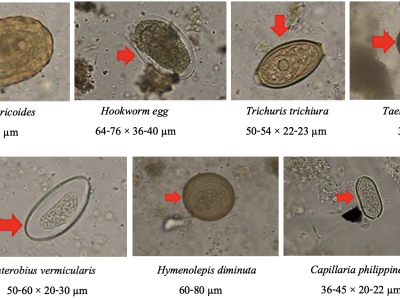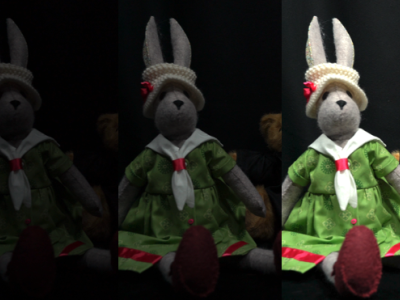Parasitic Egg Detection and Classification in Microscopic Images

- Submission Dates:
-
to
- Citation Author(s):
-
Korranat Naruenatthanaset (Chulalongkorn University)Thananop Kobchaisawat (Chulalongkorn University)
- Submitted by:
- Nantheera Anantrasirichai
- Last updated:
- DOI:
- 10.21227/vyh8-4h71
- Data Format:
- Links:
- Categories:
- Keywords:
Abstract
Parasitic infections have been recognised as one of the most significant causes of illnesses by WHO. Most infected persons shed cysts or eggs in their living environment, and unwittingly cause transmission of parasites to other individuals. Diagnosis of intestinal parasites is usually based on direct examination in the laboratory, of which capacity is obviously limited. Targeting to automate routine faecal examination for parasitic diseases, this challenge aims to gather experts in the field to develop robust automated methods to detect and classify eggs of parasitic worms in a variety of microscopic images. Participants will work with a large-scale dataset, containing 11 types of parasitic eggs from faecal smear samples. They are the main interest because of causing major diseases and illness in developing countries. We open to any techniques used for parasitic egg recognition, ranging from conventional approaches based on statistical models to deep learning techniques. Finally, the organisers expect a new collaboration come out from the challenge.
Instructions:
Datasets contain 11 parasitic egg types. Each category has 1,000 images.
- category_id 0: Ascaris lumbricoides
- category_id 1: Capillaria philippinensis
- category_id 2: Enterobius vermicularis
- category_id 3: Fasciolopsis buski
- category_id 4: Hookworm egg
- category_id 5: Hymenolepis diminuta
- category_id 6: Hymenolepis nana
- category_id 7: Opisthorchis viverrine
- category_id 8: Paragonimus spp
- category_id 9: Taenia spp. egg
- category_id 10: Trichuris trichiura
Please visit the Challenge Homepage (https://icip2022challenge.piclab.ai/).
Results must be submitted to the Leaderboard at the Challenge Homepage (https://icip2022challenge.piclab.ai/submission/).
Please cite our paper for the usage after the competition: N. Anantrasirichai, T. H. Chalidabhongse, D. Palasuwan, K. Naruenatthanaset, T. Kobchaisawat, N. Nunthanasup, K. Boonpeng, X. Ma and A. Achim, "ICIP 2022 Challenge on Parasitic Egg Detection and Classification in Microscopic Images: Dataset, Methods and Results," IEEE ICIP2022.




Dear IEEE DataPort Team,
I hope this message finds you well.
I am writing to request access to the dataset for the detection and classification of parasitic eggs in microscopic images, which is mentioned in the challenge on automating faecal examination for parasitic diseases. This dataset is critical for my research in developing automated methods to identify and classify eggs of parasitic worms, which is a significant contributor to diseases in developing countries.
Parasitic infections have been recognised as one of the major causes of illness worldwide, as highlighted by the WHO. The ability to automate the detection and classification of parasitic eggs in faecal smear samples could greatly enhance diagnostic capacities in resource-limited settings, where access to laboratory infrastructure may be limited.
As a researcher working in this domain, I am particularly interested in leveraging this dataset for deep learning techniques to develop robust models for parasitic egg recognition. I would greatly appreciate it if you could provide me with access to this dataset to further my research in this area.
Thank you for considering my request. I look forward to your response.
Best regards,
George Youhana
Dear IEEE DataPort Team,
I hope this message finds you well.
I am writing to request access to the dataset for the detection and classification of parasitic eggs in microscopic images, which is mentioned in the challenge on automating faecal examination for parasitic diseases. This dataset is critical for my research in developing automated methods to identify and classify eggs of parasitic worms, which is a significant contributor to diseases in developing countries.
Parasitic infections have been recognised as one of the major causes of illness worldwide, as highlighted by the WHO. The ability to automate the detection and classification of parasitic eggs in faecal smear samples could greatly enhance diagnostic capacities in resource-limited settings, where access to laboratory infrastructure may be limited.
As a researcher working in this domain, I am particularly interested in leveraging this dataset for deep learning techniques to develop robust models for parasitic egg recognition. I would greatly appreciate it if you could provide me with access to this dataset to further my research in this area.
Thank you for considering my request. I look forward to your response.
Best regards
Dear IEEE DataPort Team,
I hope this message finds you well.
I am a fourth-year computer science student at UCU(Ukrainian Catholic University), currently working on my diploma project focused on developing automated models for the detection and classification of parasitic eggs in microscopic images. I am writing to request access to the dataset mentioned in the challenge on automating faecal examination for parasitic diseases.
I would greatly appreciate your consideration of my request. Please let me know if there are any additional steps or information required to proceed.
Thank you for your time and support.
Best regards.
Vitalii Petrychko
Dear IEEE DataPort Team,
I hope this message finds you well.
I am writing to request access to the dataset for the detection and classification of parasitic eggs in microscopic images, as mentioned in the challenge on automating faecal examination for parasitic diseases. This dataset is essential for my research, which focuses on developing automated methods to identify and classify eggs of parasitic worms—an issue of significant concern in global health, particularly in developing countries.
Parasitic infections are recognized by the WHO as a major cause of illness worldwide. Automating the detection and classification of parasitic eggs in faecal smear samples could greatly enhance diagnostic capabilities, especially in resource-limited settings where laboratory infrastructure is scarce.
I am currently pursuing a master's degree in Health Informatics at the Federal University of Santa Catarina (UFSC) and intend to use this dataset as a fundamental component of my master's thesis. My research involves applying deep learning techniques to improve parasitic egg recognition, aiming to contribute to more efficient and accessible diagnostic solutions.
I would greatly appreciate the opportunity to access this dataset to further my research. Please let me know if there are any necessary steps or requirements for obtaining access.
Thank you for your time and consideration. I look forward to your response.
Best regards,
Halan Germano Bacca